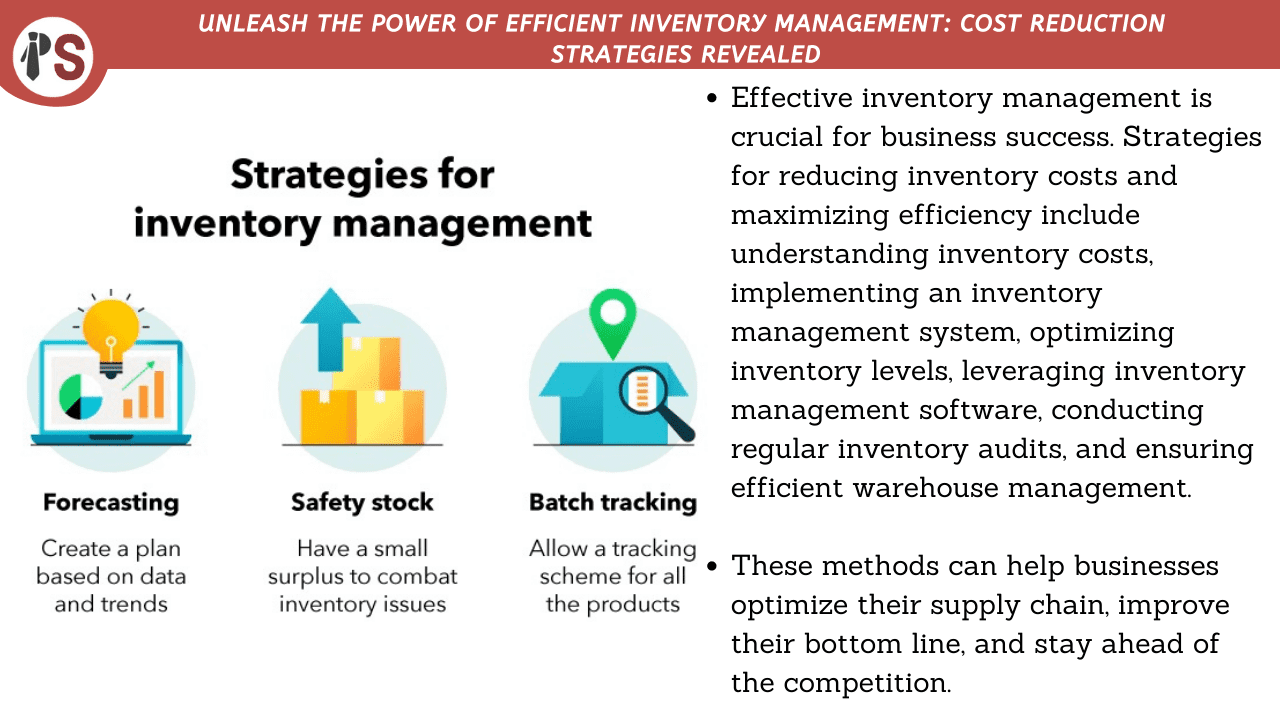
In today's competitive business landscape, effectively managing your inventory is crucial to maintaining profitability and staying ahead of the competition. Reducing inventory costs while maximizing efficiency can help you optimize your supply chain and improve your bottom line. This comprehensive guide will walk you through various strategies for achieving these goals.
Understanding Inventory Costs
Implementing an Effective Inventory Management System
Inventory Optimization Techniques
Leveraging Inventory Management Software
Regular Inventory Audits and Analysis
Efficient Warehouse Management
Conclusion
Before diving into strategies for reducing inventory costs, it's essential to understand the different types of inventory costs:
Carrying Costs: The costs associated with holding inventory, including warehousing, insurance, taxes, and depreciation.
Ordering Costs: The costs related to placing orders for inventory, such as purchasing, shipping, and handling fees.
Stockout Costs: The costs incurred when you run out of stock and cannot fulfill customer orders, which can lead to lost sales and customer dissatisfaction.
Overstock Costs: The costs associated with holding excess inventory, including additional storage and obsolescence.
An effective inventory management system is key to reducing inventory costs and maximizing efficiency. Here are some essential components of a successful system:
Accurate Demand Forecasting: Accurately predicting demand helps you maintain optimal inventory levels and avoid stockouts or overstocking.
Setting Reorder Points and Safety Stock Levels: Establishing reorder points and safety stock levels ensures that you have enough inventory on hand to meet customer demand while minimizing carrying costs.
Centralized Inventory Management: A centralized system allows you to track inventory levels across multiple locations, providing better visibility and control over your inventory.
Inventory optimization techniques can help you minimize inventory costs while maintaining adequate stock levels:
ABC Analysis: Categorize your inventory into three groups (A, B, and C) based on their value and importance. Focus on closely managing high-value (A) items, while maintaining adequate stock levels for lower-value (B and C) items.
Just-In-Time (JIT) Inventory Management: Implement JIT inventory management to reduce carrying costs by ordering stock only when needed to fulfill customer orders.
Vendor-Managed Inventory (VMI): Collaborate with suppliers to manage inventory levels, reducing the need for excessive safety stock and minimizing stockout risks.
Investing in inventory management software can help automate and streamline your inventory processes, reducing costs and increasing efficiency:
Automated Inventory Tracking: Use software to automatically track inventory levels in real-time, reducing the risk of human error and improving accuracy.
Data-Driven Decision-Making: Leverage data from your inventory management software to make informed decisions about purchasing, stocking, and inventory optimization.
Integration with Other Business Systems: Integrate your inventory management software with other business systems, such as accounting, sales, and e-commerce platforms, for a holistic view of your operations and improved efficiency.
Conducting regular inventory audits and analysis can help you identify inefficiencies, discrepancies, and opportunities for cost reduction:
Physical Inventory Counts: Perform periodic physical counts to verify the accuracy of your inventory records and identify discrepancies.
Cycle Counting: Implement cycle counting to regularly audit a subset of your inventory, reducing the disruption of full-scale physical counts.
Inventory Turnover Analysis: Calculate your inventory turnover ratio to assess how efficiently you're managing your inventory and identify areas for improvement.
Optimizing your warehouse operations can contribute to reduced inventory costs and improved efficiency:
Warehouse Layout Optimization: Arrange your warehouse to minimize travel time for pickers, reduce congestion, and facilitate smooth product flow.
First-In, First-Out (FIFO) Method: Implement the FIFO method to ensure that older inventory is sold before newer stock, reducing the risk of spoilage and obsolescence.
Cross-Docking: Utilize cross-docking to minimize storage and handling costs by directly transferring products from inbound to outbound shipments.
Reducing inventory costs and maximizing efficiency are vital for the success of any business. By understanding inventory costs, implementing an effective inventory management system, optimizing inventory levels, leveraging inventory management software, conducting regular inventory audits and analysis, and ensuring efficient warehouse management, you can significantly improve your bottom line. Stay ahead of the competition by continuously refining your inventory management strategies and adapting to changes in the market and customer demand.
At Professional Saathi, we offer a range of business consultancy services that help businesses improve their performance, achieve growth, and overcome challenges.
Copyright 2025 © Created By KTPG PROFESSIONAL SAATHI CORPORATE CONSULTANT PRIVATE LIMITED, All Rights Reserved.
Leave Your Comment